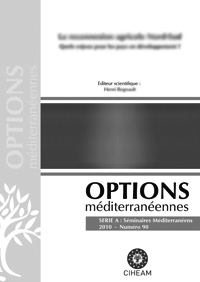| Article précédent | p. 193-196 | Article suivant |
Relative water content (RWC) and leaf senescence as screening tools for drought tolerance in wheat
Larbi A.
An experimental study has been conducted in order to analyse the response to water stress of one durum wheat variety and one bread wheat variety. The drought resistance of the cultivars was measured as the difference in their performances under two water regimes. Indicators such as relative water content (RWC) and leaf senescence were used. The RWC follow up study showed that the durum wheat, in situations of water stress, loses much more water than the bread wheat, whereas in the maximal evapotranspiration (MET) situation there are no differences. In the MET condition, the leaf life duration is the same for the two varieties. However, it is more accelerated in durum wheat than in the bread wheat in a situation of water stress.
- [ Afficher ]
- [ Télécharger ]
- [ Exporter la citation ]
Vous pouvez télécharger la citation au format :
- [ Imprimer ]
-
Mots-clés
BLE, SECHERESSE, STRESS DU A LA SECHERESSECiter cet article
Larbi A. Relative water content (RWC) and leaf senescence as screening tools for drought tolerance in wheat. In : Cantero-Martínez C. (ed.), Gabiña D. (ed.). Mediterranean rainfed agriculture: Strategies for sustainability . Zaragoza : CIHEAM, 2004. p. 193-196. (Options Méditerranéennes : Série A. Séminaires Méditerranéens; n. 60). Final Seminar of the Regional Action Programme on Rainfed Agriculture (RAP-RAG), 2003/06/02-03, Zaragoza (Spain). http://om.ciheam.org/om/pdf/a60/04600064.pdf



